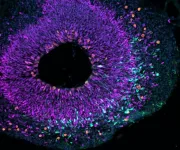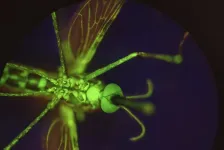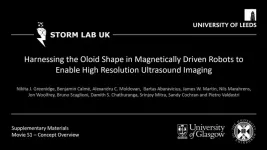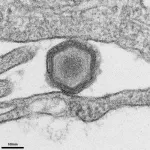(Press-News.org) Life’s essential functions are powered by a set of compounds called metabolites, which are involved in every natural process including producing energy, regulating cell activity and keeping the body’s systems in balance. Tracking these molecules offers a window into the onset and status of many diseases, overall health, response to treatment and the intricate workings of biological systems.
However, today’s metabolite sensing methods fall short. Most rely on resource-intensive lab tests that give only brief snapshots from isolated samples. The few sensors that can track metabolites continuously are largely limited to detecting blood sugar.
An interdisciplinary research team led by the California NanoSystems Institute at UCLA, or CNSI, may have overcome these limitations. In a recent study published in the Proceedings of the National Academy of Sciences, the researchers demonstrated a sensor technology based on natural biochemical processes that was able to continuously and reliably measure multiple metabolites at once from a wide range of options.
“To understand how metabolites affect biological processes or reflect health, we need to monitor different groups of metabolites based on our specific interest,” said senior corresponding author Sam Emaminejad, an associate professor of electrical and computer engineering at the UCLA Samueli School of Engineering and a CNSI member. “So we aimed to develop a sensor platform that can be applied to a wide range of metabolites while ensuring reliable operation in the body — and for that, we tapped into natural metabolic processes.”
He views this technology not as a replacement for current lab-based methods such as mass spectrometry, but as a complementary tool. Scientists could continue to use mass spectrometers for identifying potential compounds of interest and then use the sensor to monitor them in living systems.
Sensors trigger chemical reactions to broaden the menu of metabolites detected
The sensors are built onto electrodes made of tiny cylinders called single-wall carbon nanotubes. These electrodes function like miniature biochemistry labs, using enzymes and helper molecules called cofactors to perform reactions that mirror the body’s metabolic processes. Depending on the target metabolite, the sensors either detect it directly or first convert it into a detectable form through a chain of intermediary enzymatic reactions.
Detection works through enzymes that specifically catalyze electron-exchanging reactions. On the electrodes’ surface, these reactions generate an electrical current that can be measured to determine metabolite levels. Meanwhile, other enzymes work in parallel to prevent false signals by neutralizing interfering molecules, much like how enzymes detoxify substances in our bodies.
To reflect this ability to run multiple reactions in sequence and parallel, the research team is calling their technology “tandem metabolic reaction-based sensors,” or TMR sensors for short.
“Decades of research have mapped natural metabolic pathways linking metabolites to specific enzymatic reactions,” Emaminejad said. “By adapting carefully selected enzymes and cofactors for different functions, our electrodes replicate these complex reactions, enabling reliable detection of a far broader set of metabolites than conventional sensors. The robustness comes from evolution itself — enzymes and cofactors, refined over tens of millions of years, are highly sensitive, specific, and stable. We’re harnessing nature’s own blueprint and molecular machinery to track the very biochemical processes they sustain.”
Traditional enzymatic sensors mostly support single-step reactions without cofactors. By incorporating cofactors, TMR sensors can directly detect over 800 metabolites and, with just one conversion step, cover more than two-thirds of the body’s metabolites.
“The TMR electrode has additional special features for high-performance biosensing,” said Xuanbing Cheng, the study’s co-first author and a UCLA postdoctoral scholar at Emaminejad’s Interconnected and Integrated Bioelectronics Lab. “Made from single-wall carbon nanotubes, it offers a large active area for loading enzymes and cofactors. Reactions occur efficiently at low voltage, reducing undesired side reactions while maximizing the utility of enzyme activity. This allowed us to achieve exceptionally high signal-to-noise ratio measurements across a wide range of applications.”
In a series of experiments, the investigators demonstrated the technology’s ability to measure continuously and with high sensitivity a sample set of 12 clinically important metabolites. The team measured metabolites in sweat and saliva samples from patients receiving treatment for epilepsy and from individuals with conditions resembling diabetes complications. The researchers also detected a gut bacteria-derived metabolite in the brain that could cause neurological disorders if it accumulates.
Potential applications of metabolite sensors for health, research and industry
The sensors’ ability to track a wide range of metabolites across different biological settings opens new doors for human health and scientific discovery. They could transform care for metabolic and cardiovascular disorders by enabling early, precise diagnoses and tailoring treatments to an individual’s unique metabolic profile. The technology could also optimize fitness and athletic performance by tracking how the body metabolizes energy under different conditions.
In drug development, the sensors could provide real-time insights into how therapies influence metabolic pathways — from evaluating cancer drugs that block tumor growth by inhibiting enzyme activity to tracking bacterial metabolite production to optimize antibiotics.
Beyond medicine, these sensors could support industrial processes by delivering continuous feedback to improve the yield and efficiency of engineered microbes used to produce pharmaceuticals, biofuels and other valuable chemicals.
Among the many possibilities, Emaminejad is particularly excited about the technology’s potential to help unravel the gut-brain connection — an emerging frontier in biomedical research. The team is now focused on adapting their platform to tackle unanswered research questions and pursue new diagnostic opportunities.
“A major challenge in understanding how the gut and brain influence each other is capturing changes over time,” he said. “A tool that tracks metabolites continuously, rather than relying on single lab measurements, could help reveal this two-way communication. We’re finally equipped to test important hypotheses that lacked key data — helping us better understand how gut activity impacts overall health, from driving inflammation and affecting mental well-being to shaping chronic disease progression.”
The other co-first authors are UCLA graduate students Zongqi Li and Jialun Zhu from Emaminejad’s lab. Stanford biochemist Ronald Davis is a co-corresponding author. Other senior authors are Hilary Coller, a UCLA professor of molecular, cell and developmental biology and of biological chemistry; CNSI member Elaine Hsiao, a UCLA associate professor of integrative biology and physiology; Daniel Lu, a UCLA professor of neurosurgery; CNSI member Chong Liu, a UCLA professor of chemistry and biochemistry; pediatric nurse practitioner Beck Reyes and pediatric neurologist Joyce Matsumoto, both of UCLA Health; and Stanford pediatric pulmonologist Carlos Milla.
The study was funded by the National Institutes of Health, the Elisabeth K. Harris Foundation Trust, the Louis and Harold Price Foundation, the H&H Evergreen Foundation and the Jonathan and Susan Dolgen Foundation.
END
Sensor technology uses nature’s blueprint and machinery to monitor metabolism in body
2025-03-26
ELSE PRESS RELEASES FROM THIS DATE:
Chan Zuckerberg Initiative announces new biohub to develop breakthrough imaging technologies to observe cells in action
2025-03-26
REDWOOD CITY, Calif. (March 26, 2025) — The Chan Zuckerberg Initiative (CZI) announced a new grand challenge to develop groundbreaking imaging technologies to transform how scientists observe, measure and understand living cells and organisms. CZI’s two powerhouse institutes, CZ Biohub San Francisco and CZ Institute for Advanced Biological Imaging, will leverage their complementary expertise to form a new Biohub unmatched in the field of life science imaging research. They will combine their teams at a new science campus in Redwood City, Calif., adjacent to CZI ...
Encryption breakthrough lays groundwork for privacy-preserving AI models
2025-03-26
In an era where data privacy concerns loom large, a new approach in artificial intelligence (AI) could reshape how sensitive information is processed.
Researchers Austin Ebel and Karthik Garimella, Ph.D students, and Assistant Professor of Electrical and Computer Engineering Brandon Reagen have introduced Orion, a novel framework that brings fully homomorphic encryption (FHE) to deep learning — allowing AI models to practically and efficiently operate directly on encrypted data without needing to decrypt it first.
The implications of this advancement, ...
Top global award for young technologists goes to researcher who advanced AI with high-performance computers
2025-03-26
ACM, the Association for Computing Machinery, today named Torsten Hoefler, a Professor at ETH Zurich, the recipient of the 2024 ACM Prize in Computing for fundamental contributions to high-performance computing and the ongoing AI revolution. Hoefler developed many of the core capabilities of modern supercomputers and defined key aspects of the algorithms for distributing AI models on them.
The ACM Prize in Computing recognizes early-to-mid-career computer scientists whose research contributions have fundamental impact and broad implications. ...
How did the large brain evolve?
2025-03-26
The results of the study show that the two genes act in a finely tuned interplay: one ensures that the progenitor cells of the brain multiply more, while the other causes these cells to transform into a different type of progenitor cell - the cells that later form the nerve cells of the brain. In the course of evolution, this interplay has led to the human brain being unique in its size and complexity.
The newly gained insights not only provide a deeper understanding of the evolutionary development of our brain but could also help to better comprehend how certain developmental disorders or diseases of the brain arise. ‘Our findings deepen the fundamental ...
Rare disease drug nitisinone makes human blood deadly to mosquitoes
2025-03-26
In the fight against malaria, controlling the mosquito population is crucial.
Several methods are currently used to reduce mosquito numbers and malaria risk. One of these includes the antiparasitic medication ivermectin. When mosquitoes ingest blood containing ivermectin, it shortens the insect’s lifespan and helps decrease the spread of malaria.
However, ivermectin has its own issues. Not only is it environmentally toxic, but also, when it is overused to treat people and animals with worm ...
Mini rolling robot takes virtual biopsies
2025-03-26
Embargoed: Not for Release Until 2pm U.S. Eastern Time (6pm GMT) Wednesday, 26 March 2025
With images and videos
A tiny magnetic robot which can take 3D scans from deep within the body, that could revolutionise early cancer detection, has been developed by researchers.
The team, led by engineers from the University of Leeds, say this is the first time it has been possible to generate high-resolution three-dimensional ultrasound images taken from a probe deep inside the gastrointestinal ...
Researchers design tools to develop vaccines more efficiently for African swine fever virus (ASFV)
2025-03-26
Rockville, Maryland—March 26, 2024—Researchers from the J. Craig Venter Institute (JCVI), the Friedrich-Loeffler-Institut (FLI), and the International Livestock Research Institute (ILRI) have developed a reverse genetics system for African swine fever virus (ASFV). This new system will aid researchers in developing vaccines and in studying the pathogenesis and biology of ASFV, a highly contagious, deadly viral disease affecting domesticated and wild pigs, especially prevalent in Africa, Europe, Asia, and the Caribbean. A recent study estimates if ASFV reached the United States it could result ...
How survivors spanned the globe after Earth’s biggest mass extinction
2025-03-26
Scientists don’t call it the “Great Dying” for nothing. About 252 million years ago, upward of 80% of all marine species vanished during the end-Permian mass extinction – the most extreme event of its kind in Earth’s history.
What followed was a mysterious, multimillion-year span that could be called the “Great Dulling,” when marine animal communities looked remarkably alike all over the planet, from the equator to the poles. Researchers have long sought an explanation for this so-called taxonomic homogenization – a scene that played out after other mass extinctions over the past ...
Even in egalitarian Sweden, a "culture of silence" may prevent university staff and students from reporting sexual harassment
2025-03-26
Even in egalitarian Sweden, a "culture of silence" may prevent university staff and students from reporting sexual harassment, with just an 8.1% reporting rate for students who had experienced either rape or attempted rape.
####
Article URL: https://plos.io/4bW0elh
Article title: What determines the ‘culture of silence’? Disclosing and reporting sexual harassment among university employees and students at a large Swedish public university
Author countries: Sweden
Funding: This work was funded by the Swedish Research Council, ...
Data from the Healthy Minds Study of 140 college campuses in the US suggests that religiousness may be protective against symptoms of depression in students, although less so in sexual minorities
2025-03-26
Data from the Healthy Minds Study of 140 college campuses in the US suggests that religiousness may be protective against symptoms of depression in students, although less so in sexual minorities.
####
Article URL: https://plos.io/3XwiyM6
Article Title: Religiousness, sexual orientation, and depression among emerging adults in U.S. higher education: Findings from the Healthy Minds Study
Author Countries: Spain, United Kingdom, United States
Funding: The authors received no specific funding for this work. END ...





